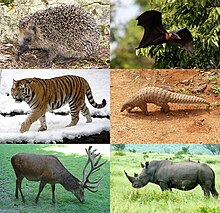|
Boreoeutheria
|

|
| De cima para a direita: ouriço-terrestre, raposa-voadora-de-Lyle, tigre-siberiano, pangolim-indiano, veado-vermelho e um rinoceronte-branco. Representando as ordens: Eulipotyphla, Chiroptera, Carnivora, Pholidota, Artiodactyla e Perissodactyla, composta de Laurasiatheria.
|

|
| De cima para esquerda: Galeopterus variegatus, Capromys pilorides, Hylobates lar, lebre-comum, Rattus norvegicus, Tupaia glis, lémure-de-cauda-anelada, e um Humano brincando com um coelho-doméstico. Representando as ordens: Dermoptera, Rodentia, Primates, Lagomorpha, e Scandentia, composta de Euarchontoglires.
|
Classificação científica 
|
| Domínio:
|
Eukaryota
|
| Reino:
|
Animalia
|
| Filo:
|
Chordata
|
| Classe:
|
Mammalia
|
| Clado:
|
Eutheria
|
| Infraclasse:
|
Placentalia
|
| Magnordem:
|
Boreoeutheria
Springer & de Jong, 2001[1]
|
| Superordens
|
|
|
| Sinónimos
|
- Boreoplacentalia (Arnason, 2008)[2]
- Boreotheria (Waddell, 2001)[3]
|
Os boreoeutérios (Boreoeutheria, do grego boreas "vento norte", e Eutheria "eutérios") são uma divisão dos Placentalia que incluiria os subgrupos Laurasiatheria e Euarchontoglires atualmente suportado pela análise da sequência de DNA.
Esta é a filogenia de acordo com estudos genéticos recentes:[4][5]
Referências
- ↑ Springer M. S. and de Jong W. W. (2001.) "Which mammalian supertree to bark up?" Science 291, 1709–1711
- ↑ Arnason U., Adegoke J. A., Gullberg A., Harley E. H., Janke A., Kullberg M. (2008.) "Mitogenomic relationships of placental mammals and molecular estimates of their divergences." Gene.; 421(1-2):37–51
- ↑ Waddell, Peter J.; Kishino, Hirohisa; Ota, Rissa (2001). «A phylogenetic foundation for comparative mammalian genomics». Genome Informatics. 12: 141–154. PMID 11791233
- ↑ Morgan, CC; Foster, PG; Webb, AE; Pisani, D; McInerney, JO; O'Connell, MJ (2013). «Heterogeneous models place the root of the placental mammal phylogeny». Mol Biol Evol. 30 (9): 2145–256. PMC 3748356
 . PMID 23813979. doi:10.1093/molbev/mst117 . PMID 23813979. doi:10.1093/molbev/mst117
- ↑ Waddell, Peter J.; Okada, Norohiro; Hasegawa, Masami. «Towards Resolving the Interordinal Relationships of Placental Mammals». Biología sistematica. 48 (1): 1–5. PMID 12078634. doi:10.1093/sysbio/48.1.1
- Waddell PJ, Kishino H, Ota R (2001) A phylogenetic foundation for comparative mammalian genomics. Genome Inform Ser Workshop Genome Inform 12: 141–154.
- William J. Murphy, Eduardo Eizirik, Mark S. Springer et al., Resolution of the Early Placental Mammal Radiation Using Bayesian Phylogenetics,Science, Vol 294, Issue 5550, 2348-2351 , 14 December 2001.
- Kriegs, Jan Ole, Gennady Churakov, Martin Kiefmann, Ursula Jordan, Juergen Brosius, Juergen Schmitz. (2006) Retroposed Elements as Archives for the Evolutionary History of Placental Mammals. PLoS Biol 4(4): e91.[1] (pdf version)
- Blanchette M, Green ED, Miller W, Haussler D. (2004) Reconstructing large regions of an ancestral mammalian genome in silico. Genome Res. 2004 Dec;14(12):2412-23. ([2])
- Ma J, Zhang L, Suh BB, Raney BJ, Burhans RC, Kent WJ, Blanchette M, Haussler D, Miller W. (2006) Reconstructing contiguous regions of an ancestral genome. Genome Res. 2006 Dec;16(12):1557-65. Epub 2006 Sep 18. ([3])
Ligações externas
|

